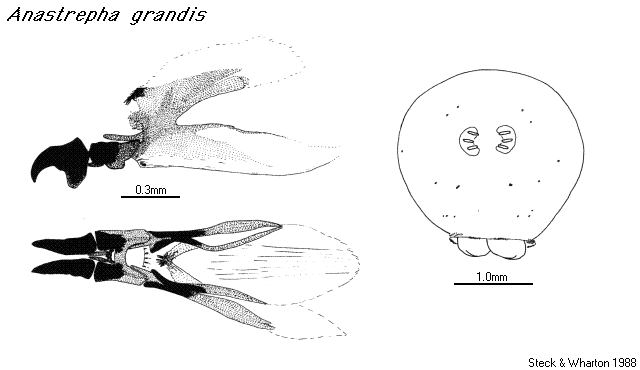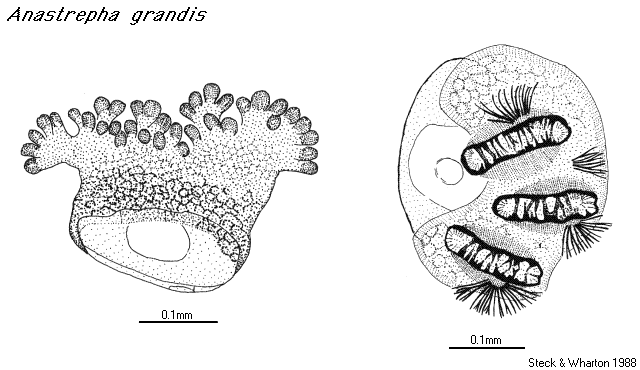Anastrepha grandis
Common name
South American cucurbit fruit flyDescription
Typical of Anastrepha larvae with the following specific characteristics for the third instar:
Body. Large, body length 6.6–17.0 mm
Head.Number of oral ridges usually 9–11 (range 8–13).
Cephalopharyngeal skeleton.
Spinules and creeping welts. Dorsal spinules on segments T1-A3, or T1-A4, or T1-A5
Anterior spiracles. Anterior spiracular tubules usually 31-37 (range 28–37); in a single irregular row, or in two rows.
Caudal segment (A8) and anal lobes. Anal lobes plainly visible, but not protuberant; bifid.
Posterior spiracles. Average length of dorsal and ventral rimae 120–163µm; slits 3.1–5.3x longer than wide. Dorsal spiracular processes with numerous trunks arising from a short or semicircular base, or with fewer trunks radiating from a short or semicircular base (medium processes). Number of dorsal spiracular processes 11–22. Number of ventral spiracular processes 11–20. Number of lateral spiracular processes usually 6–13 (range 6–15). Basal width of spiracular processes 14–46µm (SPI:22–46; SPIV:14–36). Dorsal and ventral spiracular processes: average number of tips 16–36. Dorsal and ventral spiracular processes: ratio of number of tips to number of trunks 1.2–2.9..
Host plants
| Family | Genus / species |
| Cucurbitaceae | Citrullus lanatus |
| Cucurbita maxima, C. moschata, C. pepo | |
| Lagenaria siceraria |
Part of plant attacked: fruit.
Biogeographic region and distribution
Neotropical
Central America: Panama.
South America: Argentina, Bolivia, Brazil, Colombia, Ecuador, Paraguay, Peru, Venezuela.
Status of knowledge
The egg, second and third instar larva, and puparium were described and illustrated by Steck and Wharton (1988).Specimens examined
Based on description by Steck and Wharton (1988): Brazil: Sao Paulo, ex melon culture (n=5), ex pumpkin culture (n=18); Argentina: pumpkin intercepted 1–4–37 Houston Tex. -2003 Lot 37–521, n=11, no associated adults; NMNH.Adult taxonomy
Anastrepha grandis (Macquart)
Tephritis grandis Macquart 1846: 340.—Nouvelle-Grenade [Colombia or Venezuela]. LT ♀ UMO. Lectotype designated by Norrbom 1991: 119.
Anastrepha schineri Hendel 1914]: 69.—Bolivia. T ♂ MNM.
Anastrepha latifasciata Hering 1935]: 227.—Brazil. Santa Catarina. HT ♀ PAN.
Anastrepha schineri Hendel 1914: 19.—Bolivia. La Paz: Coroica [Coroico]. HT ♂ MNM. Preocc. Hendel 1914: 69.
References
Carroll, L. E., A. L. Norrbom, M. J. Dallwitz, and F. C. Thompson. 2004 onwards. Pest fruit flies of the world – larvae. Version: 8th December 2006. http://delta-intkey.com.Steck, G.J. and R.A. Wharton. 1988. Description of immature stages of Anastrepha interrupta, A. limae and A. grandis (Diptera: Tephritidae). Annals Entomological Society America 81: 994-1003.
Steck, G. J., L. E. Carroll, H. Celedonio H. & J. C. Guillen A. 1990. Methods for identification of Anastrepha larvae (Diptera: Tephritidae), and key to 13 species. Proc. Entomol. Soc. Wash. 92: 333-346.





